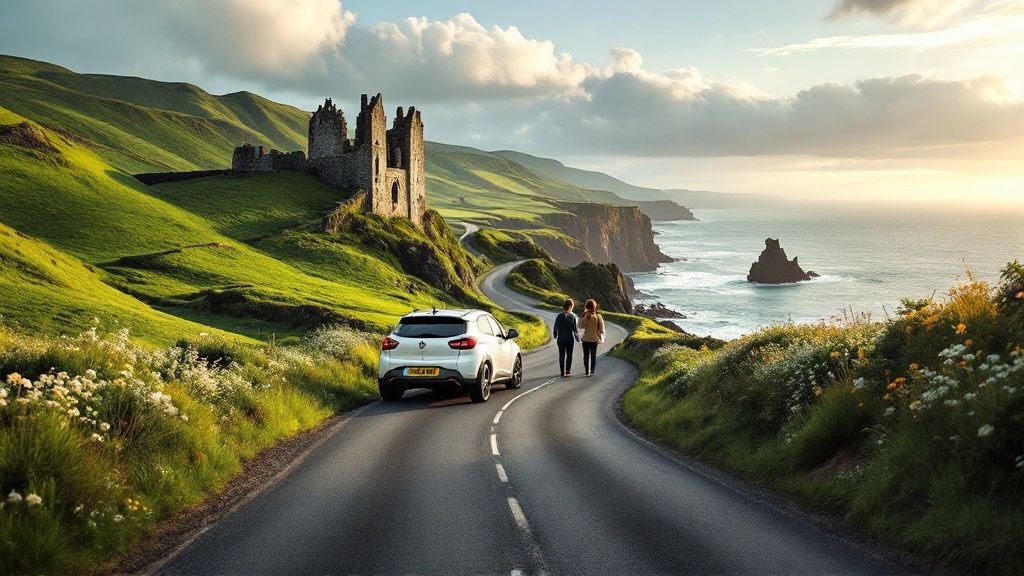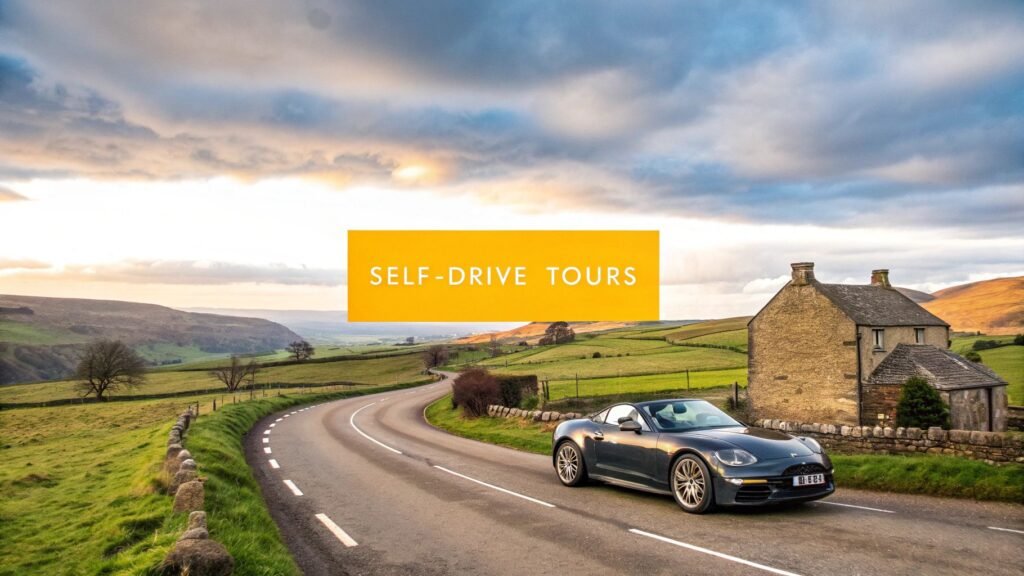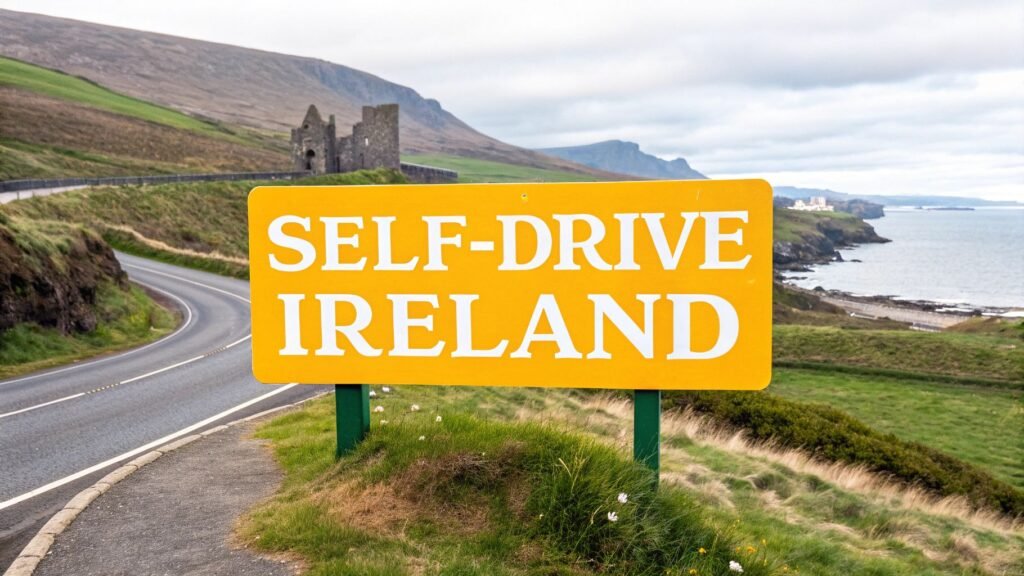There's a special kind of magic in exploring Ireland on your own terms. The best tours of Ireland are often the ones you create yourself, behind the wheel, with the freedom to follow the road wherever it leads. A self-drive itinerary lets you experience the Emerald Isle’s breathtaking coastlines and sleepy villages at a pace that feels right for you. It’s about lingering a little longer at a crumbling castle, taking a spontaneous turn down a winding country lane, and stumbling upon those hidden gems that never make it into the guidebooks.
Why a Self-Drive Tour of Ireland Is Unforgettable
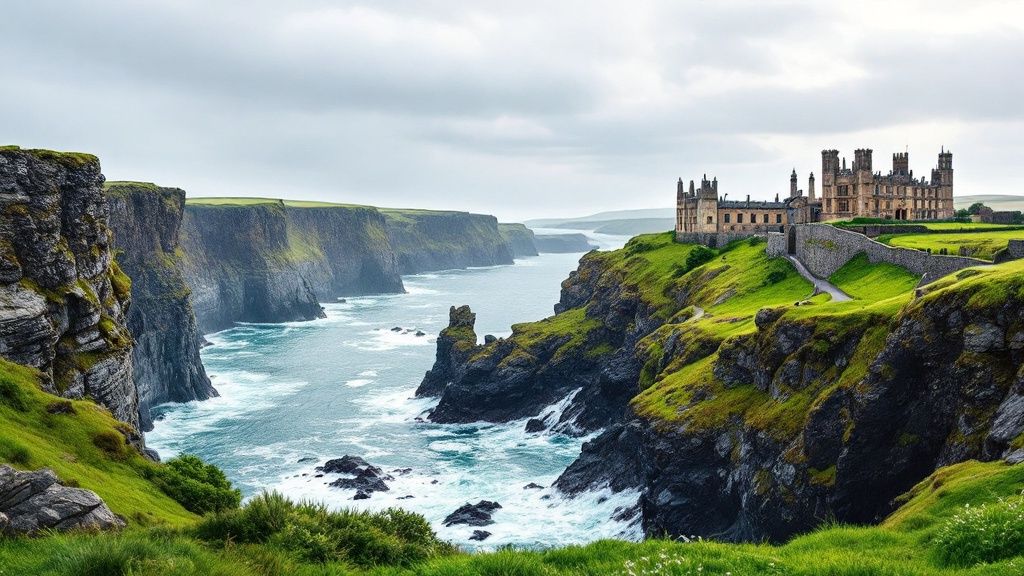
Think of Ireland less as a checklist of sights and more as a story waiting for you to write it. Of course, guided bus tours have their perks, but a self-drive trip puts you firmly in the driver's seat—literally and figuratively. It shifts your holiday from a passive viewing into an active exploration, where you set the schedule and every single day is yours to shape.
This is where spontaneity comes to life. See a sign for a Neolithic tomb that wasn't on your radar? Go and have a look. Fall completely in love with the atmosphere in a tiny fishing village? Why not stay another night? That kind of freedom is what makes an Irish holiday truly unforgettable.
The Freedom of the Open Road
At its heart, the real appeal of a self-drive tour in Ireland is the sheer flexibility. You’re not tied to a strict timetable or the preferences of a large group. Instead, you can build a journey that revolves entirely around your passions, whether that’s delving into ancient history, hiking coastal paths, or simply finding the perfect pint of Guinness in a cosy, traditional pub.
This freedom creates a much deeper, more authentic connection with the country. You'll be driving the same charmingly narrow roads as the locals, stopping at family-run cafés for a chat, and discovering jaw-dropping viewpoints that aren’t swarming with tour buses. It’s the difference between seeing Ireland and truly experiencing it.
Crafting Your Personal Irish Saga
Planning your self-drive tour is like being the author of your own travel adventure. Every decision you make—from the route you plot to the B&B you book for the night—adds a unique chapter to your story. This guide is here to be your co-author, giving you the inspiration and practical know-how to bring it all together.
We'll walk through everything you need to build your perfect trip:
- Iconic Routes: From the rugged cliffs of the Wild Atlantic Way to the historic landscapes of Ireland's Ancient East. Find out more about the iconic Wild Atlantic Way in our detailed guide.
- Essential Logistics: Real-world tips for hiring a car, getting comfortable on winding roads, and picking the right places to stay.
- Cultural Immersion: How to dive into local life, from finding an authentic traditional music session to savouring proper Irish food.
By the end of this guide, you won't just have a map. You'll have a blueprint for an incredible journey, designed by you, for you. Your Irish adventure starts now.
Choosing Your Ideal Ireland Touring Route
Picking the right route for your self-drive holiday is the most important decision you'll make. It sets the entire tone for your trip. Each of Ireland's main touring routes tells a different story, with its own unique personality, scenery, and slice of history. Finding the one that clicks with you is the first step to an unforgettable adventure.
Think of it this way: are you looking for a blockbuster action movie, a deep historical drama, or a quiet, contemplative indie film? Do you want the constant thrill of a wild coastline, or would you rather lose yourself in the quiet whispers of ancient ruins? Let's break down the character of each of Ireland's premier routes to help you find your perfect match.
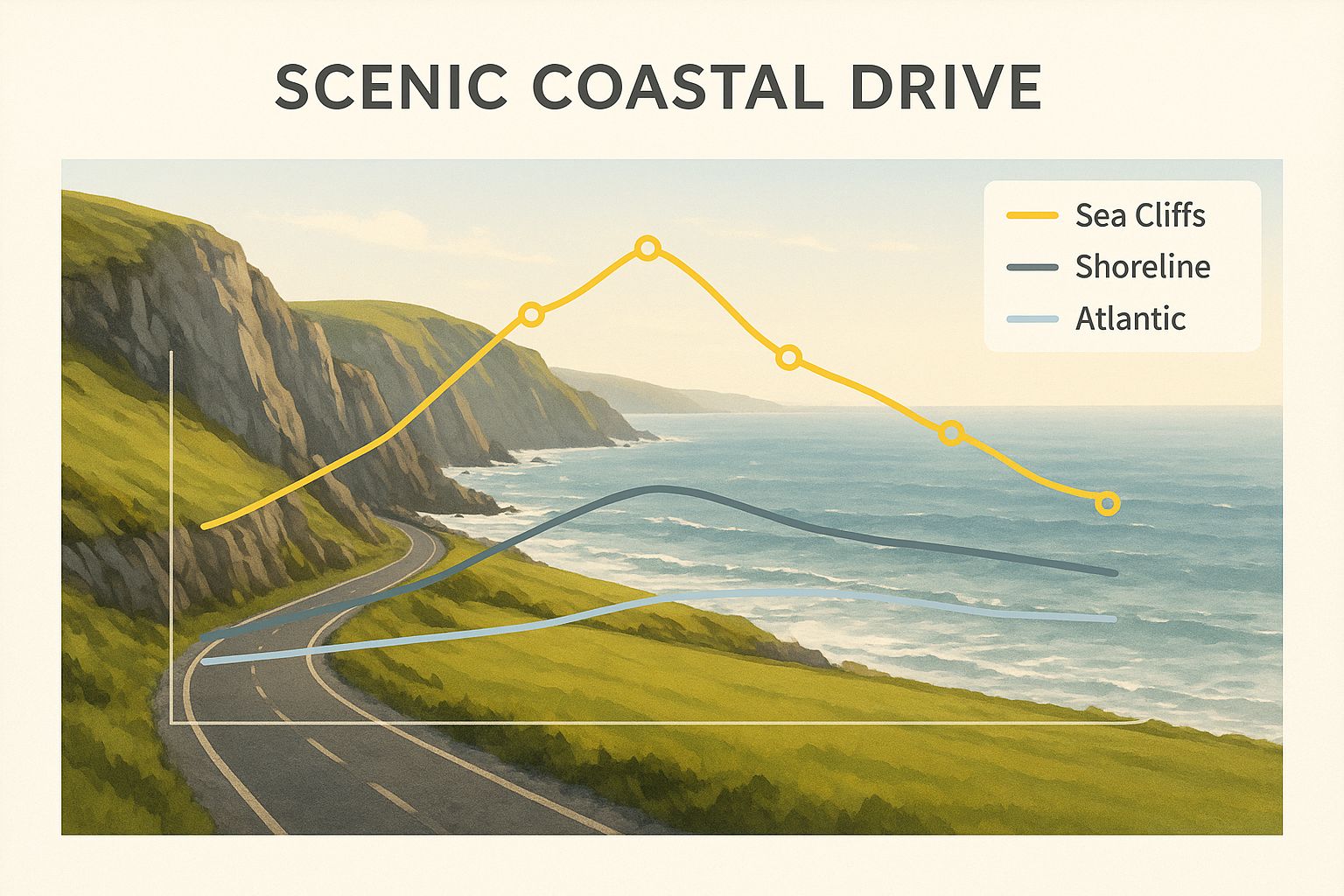
The image above gives you a real sense of the stunning contrasts you’ll encounter, especially that dramatic meeting of land and sea that makes so many of these journeys famous.
Comparing Ireland's Top Self-Drive Touring Routes
To help you choose, here's a quick-glance comparison of the main routes. Think about your interests, how much time you have, and the kind of experience you’re hoping for.
| Route Name | Key Highlights | Best For | Typical Duration |
|---|---|---|---|
| The Wild Atlantic Way | Cliffs of Moher, Ring of Kerry, Dingle Peninsula | Scenery lovers, adventurers, photographers | 10–14 days |
| Ireland's Ancient East | Brú na Bóinne, Glendalough, Rock of Cashel | History buffs, storytellers, culture seekers | 5–7 days |
| The Causeway Coastal Route | Giant's Causeway, Carrick-a-Rede Rope Bridge | Scenery lovers, Game of Thrones fans | 2–3 days |
| Ireland's Hidden Heartlands | River Shannon, Beara-Breifne Way, rural towns | Relaxation, nature, escaping the crowds | 4–6 days |
This table should give you a solid starting point, but let’s dive a little deeper into what makes each route so special.
The Wild Atlantic Way
This is Ireland's epic. The big one. Stretching for over 2,500 kilometres along the entire west coast, the Wild Atlantic Way is one of the longest coastal drives on the planet. This is the Ireland you've seen on postcards—where immense cliffs drop into the Atlantic and ancient stone forts cling to windswept headlands.
This route is for the adventurer at heart. It’s for the photographer who can't put their camera down and for anyone who feels a pull towards the raw, untamed power of the ocean. You really need to take your time here; I'd recommend at least 10 to 14 days to do it justice. You’ll be winding your way through counties like Cork, Kerry, Clare, and Donegal, hitting all the big names like the Ring of Kerry and the Cliffs of Moher.
Ireland's Ancient East
If the Wild Atlantic Way is the blockbuster, then Ireland's Ancient East is a sprawling historical novel. Covering the land east of the River Shannon, this region packs in 5,000 years of stories. The landscape is literally layered with history, from Neolithic tombs older than the pyramids to imposing Norman castles and elegant country estates.
This route is a dream for history buffs and anyone who loves digging into the stories behind a place. It’s a true journey through time, where you can connect with Celtic warriors, early Christian saints, and medieval lords. You can explore the Boyne Valley, home to the UNESCO World Heritage site of Brú na Bóinne, or find a moment of peace in the monastic city of Glendalough. To get started, you can learn more about planning your trip to Ireland's Ancient East.
The Causeway Coastal Route
Up in Northern Ireland, the Causeway Coastal Route is short, sharp, and incredibly dramatic. It's often called one of the world's greatest road trips, and for good reason. It crams an unbelievable amount of stunning scenery and famous sites into just 190 kilometres between Belfast and Derry/Londonderry.
Of course, its crown jewel is the Giant's Causeway, a bizarrely beautiful landscape of some 40,000 interlocking basalt columns. But you’ve also got the thrilling Carrick-a-Rede Rope Bridge, the romantic ruins of Dunluce Castle, and plenty of filming locations for Game of Thrones fans. It’s the perfect drive if you’re short on time but still want maximum impact—you can easily see the highlights in 2 to 3 days.
Ireland's Hidden Heartlands
Looking to get away from the main tourist trail and find a slower, more authentic pace? Ireland's Hidden Heartlands is your answer. Centred around the mighty River Shannon, this region is all about lush green landscapes, peaceful waterways, and unspoiled countryside charm.
This is the route for anyone who wants to properly unwind. The focus isn't on rushing from one major attraction to the next; it’s about enjoying the journey itself.
- What you'll do: Think about cruising down the river, cycling along quiet greenways, or simply exploring the lovely little towns and villages dotted along the riverbanks.
- Who it's for: People who want to slow down, connect with nature, and see a side of Ireland that many visitors miss.
- How long you'll need: A 4 to 6-day trip gives you plenty of time to relax and explore this peaceful part of the country.
Ultimately, the best route is the one that tells the kind of story you want to live on your Irish holiday.
Crafting Your Day-by-Day Irish Itinerary
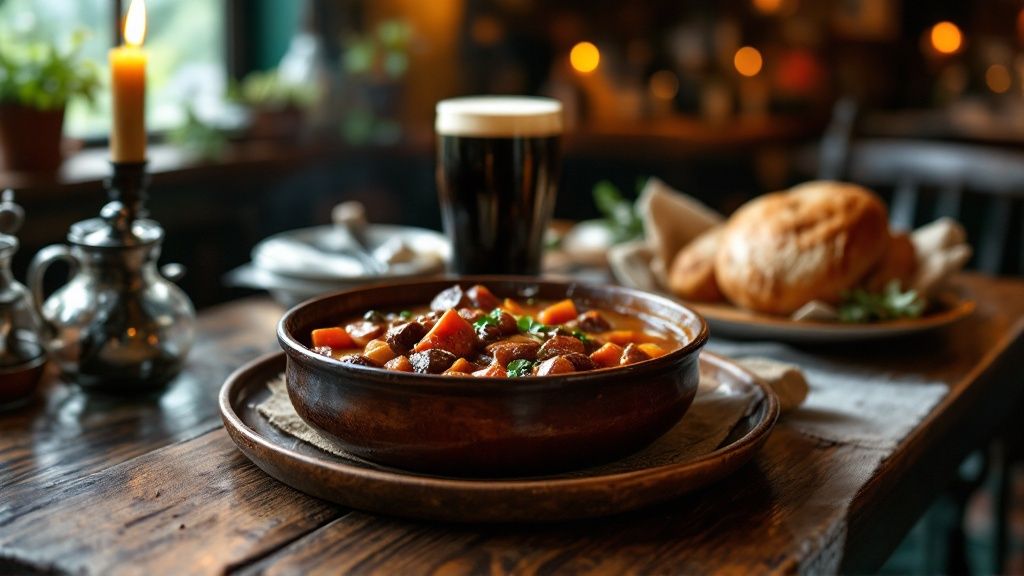
Alright, you’ve picked a general route. Now for the fun part: turning that rough sketch into a living, breathing day-by-day plan. A great itinerary isn’t just a checklist of places to see. It’s more like a recipe for a perfect adventure, carefully balancing driving time with discovery, big-ticket sights with quiet, unexpected moments.
The secret to a fantastic self-drive trip in Ireland is all about pacing. On a map, the country looks tiny, but those winding country roads and the sheer number of things worth stopping for can make travel times much longer than you’d think. Trying to cram too much in is the quickest way to miss the real magic. The goal is to find a relaxed rhythm that leaves room for you to be spontaneous.
To give you a running start, I’ve put together three sample itineraries. Think of them as templates. You can follow them closely, mix and match bits you like, or just use them as a spark of inspiration to build your own perfect journey. Each one is built around realistic driving days and a good mix of famous sights and hidden gems.
The 7-Day Southern Loop: A Taste of Ireland
Perfect for first-timers, this classic one-week trip gives you a fantastic introduction to the Republic of Ireland’s most beloved highlights without ever feeling like a mad dash.
- Day 1-2: Dublin & Wicklow: Land in Dublin, pick up your car, and give yourself a day to soak up the capital’s energy. The next morning, head south into the "Garden of Ireland" to see the ancient monastic site of Glendalough. Your stop for the night is Kilkenny, a gorgeous city known for its medieval castle and buzzing pub scene.
- Day 3: Rock of Cashel & Cork: Make your way to the iconic Rock of Cashel, a breathtaking cluster of medieval buildings perched on a hilltop. From there, continue on to Cork, Ireland’s second city. Spend the evening exploring the famous English Market and enjoying the fantastic food and culture.
- Day 4-5: The Ring of Kerry: You’ll want two full days for this one. It's one of the world's most famous scenic drives for a reason. Set up camp in a town like Killarney or Kenmare and take your time exploring the peninsula’s dramatic coastline, quaint villages, and historic sites.
- Day 6-7: Cliffs of Moher & Galway: Drive north up the coast to the awe-inspiring Cliffs of Moher. Afterwards, it’s on to the bohemian city of Galway. Catch some traditional music, soak in the lively atmosphere, and then begin the drive back towards Dublin for your flight home.
The 10-Day Wild Atlantic Way Explorer
If you’ve got a bit more time, this itinerary lets you properly sink your teeth into the rugged beauty of Ireland’s west coast. This is an adventure all about dramatic landscapes, wild seas, and the untamed spirit of the Atlantic.
Just remember, the entire Wild Atlantic Way stretches over 2,500 km. This 10-day plan smartly focuses on the most spectacular southern and central sections, from Cork up to Galway. You'll get the true essence of the route without spending your whole holiday behind the wheel.
- Days 1-3: West Cork & Kerry: Kick things off in Cork and explore the stunning peninsulas of Mizen Head and Sheep's Head. Then, dedicate a couple of days to the raw beauty of the Dingle Peninsula and its iconic Slea Head Drive.
- Days 4-6: The Burren & Cliffs of Moher: Take the ferry across the Shannon Estuary into County Clare. Spend a good amount of time wandering the unique, moon-like landscape of the Burren National Park before your unforgettable visit to the Cliffs of Moher.
- Days 7-8: Galway & Connemara: Make Galway your base and take a day trip out into the wild, windswept landscapes of Connemara National Park. Don’t miss Kylemore Abbey and the charming town of Clifden.
- Days 9-10: The Journey Home: Start heading back east. A great potential stop is the ancient Clonmacnoise monastic site on the River Shannon, which offers a final, powerful dose of history before your last night.
The 14-Day All-Ireland Discovery
This is the ultimate two-week road trip. It combines the must-sees of the Republic with the unique character of Northern Ireland, giving you a complete picture of the island's incredible diversity.
- Week 1: Southern Wonders: Your first week will look a lot like the 7-day loop, taking you through Dublin, Kilkenny, the Ring of Kerry, the Cliffs of Moher, and Galway. This builds a fantastic foundation in the south.
- Days 8-10: Donegal & Derry: From Galway, head north into County Donegal, a region famous for its spectacular coastline and the staggering Slieve League cliffs. Cross the border into Northern Ireland to explore the historic walled city of Derry.
- Days 11-12: Causeway Coastal Route: Prepare for one of the greatest road trips on the planet. You’ll visit the Giant's Causeway, cross the Carrick-a-Rede Rope Bridge, and see the dramatic clifftop ruins of Dunluce Castle. If you're a TV fan, many of these spots will look very familiar. In fact, you can find more screen-themed ideas in our Game of Thrones 8-day self-drive tour of Ireland.
- Days 13-14: Belfast & the Ancient East: Dive into Belfast to explore the city and its fascinating Titanic Quarter. On your last day, drive south towards Dublin, making a stop in the Boyne Valley to marvel at the prehistoric wonder of Newgrange.
These sample plans are here to give you a solid framework. But the real joy of a self-drive tour is the freedom to colour outside the lines—so don't be afraid to make the journey entirely your own.
Picking the Right Season for Your Irish Road Trip
Deciding when to go on your Irish road trip is just as crucial as figuring out where you’re going. Ireland’s famously unpredictable weather doesn’t just influence your packing list; it completely sets the mood for your entire adventure. The time of year affects everything from the colour of the hillsides to the number of people you'll be sharing the views with.
Think of it this way: each season provides a different soundtrack for your trip. Summer is a bright, energetic score, with long, sun-drenched days perfect for cramming in just one more castle or scenic viewpoint. Winter, on the other hand, is more atmospheric and dramatic, with moody skies that make the promise of a crackling pub fire even more enticing. One isn't better than the other; they just create a different kind of Irish magic.
Spring (March to May)
This is when Ireland truly earns its "Emerald Isle" reputation. The whole country seems to wake up, with landscapes exploding in a riot of vibrant green, daffodils popping up along country lanes, and fields full of new lambs. For photographers and anyone who loves the outdoors, it's an absolutely stunning time to visit.
- Weather and Daylight: You’ll get a bit of everything—glorious sunny spells mixed with that classic, soft Irish rain. Temperatures are generally mild but still crisp, and the days are getting noticeably longer.
- Crowds and Cost: You’re getting in just ahead of the summer rush. That means fewer people at the major attractions and better deals on car hire and places to stay.
Summer (June to August)
There’s a reason this is peak season. Summer offers the best odds for warm, settled weather and wonderfully long days. With daylight stretching past 10 pm, it's the perfect time for anyone looking to squeeze every last drop out of their tours of Ireland, whether that means hiking a mountain trail or wandering through ancient ruins in the late evening light.
Of course, all that sunshine comes with company. To give you an idea, in June 2025, Ireland saw around 654,500 visitors from overseas, and 47% of those were on holiday. This means the famous spots will be buzzing, so booking your car and accommodation well in advance is a must. You can find more Irish tourism trends on CSO.ie to see the full picture.
Autumn (September to November)
Many seasoned travellers will tell you that autumn is the real sweet spot. The summer crowds have mostly gone home, but the weather, especially in September, can still be lovely and mild. The scenery undergoes a beautiful change, with the greens giving way to rich golds, reds, and browns, creating a spectacular, atmospheric backdrop for your drives.
As the days get shorter and a chill creeps into the air, a certain cosiness settles over the country. It’s the perfect season for a day of exploring scenic routes, followed by a hearty pub dinner and some live traditional music.
Winter (December to February)
A winter trip is for those chasing a more solitary, dramatic kind of beauty. It’s definitely the coldest and wettest time of year, but driving through Ireland in winter reveals a completely different character. Picture windswept coastlines, starkly beautiful mountain passes, and the profound silence of ancient stone circles without another soul in sight.
It’s also the most affordable time to visit. The shorter days are simply an invitation to fully embrace one of the best Irish experiences there is: getting cosy next to a glowing peat fire in a local pub. If you don’t mind bundling up, winter offers a powerful and incredibly intimate way to connect with the wild, timeless spirit of the Emerald Isle.
Getting the Hang of Your Irish Road Trip
Alright, you’ve sketched out a route and picked the perfect time of year. Now it’s time to get into the nitty-gritty details. This is the stuff that turns a good idea into a genuinely great, stress-free trip. Sorting out the logistics—from the car you hire to figuring out the quirks of rural roads—is what lets you truly relax and enjoy one of our self-drive tours of Ireland.
Think of this part as setting the stage for an unforgettable performance. You wouldn't just wander onto a stage without a script, and you shouldn't hit the road in a new country without a handle on the basics. Let’s walk through the essentials that will keep your journey running smoothly from the second you get the keys.
Picking and Hiring Your Car
The car you hire is going to be your home-on-wheels, so choosing the right one is a big deal. Irish roads, especially the scenic country ones, can be a lot narrower than what you might be used to back home. A smaller, more compact car is almost always the better bet. You’ll thank yourself when you’re navigating a tight squeeze in a historic village or a winding coastal lane.
Next up: gearbox. The vast majority of hire cars in Ireland come with a manual transmission (stick shift). If you're not 100% comfortable driving manual, you absolutely must book an automatic well in advance. They’re less common and get snapped up fast, particularly in high season. It might cost a bit extra, but the peace of mind is worth every penny.
Then there’s insurance, which can feel a bit baffling at first. Here’s a simple breakdown:
- Collision Damage Waiver (CDW): This is usually part of the standard hire price, but it comes with a seriously high excess (the amount you’re liable for if there’s damage).
- Super CDW: This is an add-on that brings that excess way down, often to zero. It adds to the daily hire cost, but for a truly worry-free trip, it’s what I’d always recommend.
Navigating Irish Roads Like a Local
Driving in Ireland is an adventure in itself, full of unique charms and a few quirks. The roads are generally in good shape, but they come in all shapes and sizes. You'll find modern motorways (marked with an 'M'), which are fantastic for getting between major cities quickly.
The national roads ('N' roads) are your main arteries connecting towns, usually single-lane highways. But the real magic happens on the regional ('R') and local ('L') roads. These are the classic narrow, winding lanes, often hemmed in by ancient stone walls or thick hedgerows, that take you to Ireland's best-kept secrets. The tiniest of these are affectionately known as 'boreens'.
On these smaller roads, just take it easy. A short distance on the map can take much longer than you think. That's not a bug; it's a feature. Embrace the slower pace and soak in the views.
Road signs have their own character, too. In the Republic of Ireland, signs in Gaeltacht (Irish-speaking) regions might be in Irish only, though most are bilingual—Irish in italics above the English in capital letters. Distances are shown in kilometres, and speed limits are in kilometres per hour (km/h). You'll also encounter a lot of roundabouts; the golden rule is to always give way to traffic already on it, coming from your right. When sorting your travel tech, having reliable internet for your road trip is a game-changer for using GPS and staying in touch, especially out in the countryside.
Budgeting and Where to Stay
Beyond the car hire, you'll need to budget for fuel, tolls, and parking. Petrol and diesel prices are likely higher than you're used to, and some motorways have tolls where you can typically pay with cash or card. In cities and larger towns, parking is usually pay-and-display.
Where you rest your head at night really shapes your experience. Ireland has a fantastic range of options for every taste and budget:
- Bed & Breakfasts (B&Bs): This is the quintessential Irish stay. You get a cosy room in a family home, a legendary "full Irish" breakfast, and brilliant local advice from your hosts.
- Hotels: These run the gamut from budget-friendly chains to unbelievably luxurious castle hotels, offering more services and amenities.
- Self-Catering Cottages: Perfect for families or anyone staying for a week or more. Renting a cottage gives you a proper home base and the freedom to cook for yourself.
It’s always a good idea to book your accommodation ahead of time, especially if you’re travelling during the summer. If you’d rather have all of this taken care of for you, looking into professionally organised self-drive tours is a brilliant way to go. You get all the freedom of a road trip but with the reassurance of expert planning.
Experiencing True Irish Culture Beyond the Scenery
Let’s be honest, the real soul of Ireland isn’t just found in its epic landscapes or crumbling castles, as stunning as they are. You find it in the buzzing, vibrant culture that thrums through its towns and villages. To really get Ireland, you need to connect with its people, its traditions, and the unique rhythm of its social life. It's about stepping past the postcard views and diving into the everyday magic.
Often, that journey begins in a local pub. And I don’t just mean a place to grab a pint. The Irish pub is the community’s living room—it's the epicentre of storytelling, laughter, and, of course, music. Don't be shy. Pull up a stool, order a drink, and just soak in the chatter around you. It's in those moments you'll feel the true heartbeat of a place.
Finding the Pulse of Ireland
Engaging with the local culture is all about taking part, not just being a spectator. It’s about seeking out those genuine experiences that stick with you long after you've returned home. While the scenery provides a spectacular backdrop, it's these cultural encounters that become the main characters in your travel story.
To get started, here are a few things to look for:
- Traditional Music: You absolutely have to find a "trad session." These informal musical gatherings are wonderfully authentic. Look for pubs advertising live music, but just know it often runs on "Irish time"—meaning it'll probably start a bit later than planned!
- Local Food: Try to venture beyond the restaurants aimed squarely at tourists. Ask a shopkeeper or your B&B host where they’d go for a proper stew or the day's freshest catch. Tasting regional specialities is a delicious way to connect with an area's heritage.
- Deeper History: Visit sites that tell a more profound story. The serene monastic city of Glendalough or the prehistoric marvel of Newgrange offer powerful glimpses into Ireland's ancient soul, giving you a real context for the modern culture you see today.
The Art of the Irish Pub
The pub is absolutely central to social life here. It’s a tradition so ingrained that when Irish people travel, they bring that culture with them. For example, in 2023, there were 2.9 million visits from the Republic of Ireland to the UK, with visitors spending a record £1.2 billion. And what were some of their top activities? Pub and restaurant visits, of course. It just shows how vital these social hubs are. You can read more fascinating Irish visitor trends from VisitBritain.org.
When you walk into a pub, a few bits of etiquette will help you blend right in. It’s normal to order your drinks at the bar, rather than waiting for someone to come to your table, especially in more traditional spots. If you're lucky enough to stumble upon a trad session in full swing, remember it’s a performance deserving of respect—keep your voice down and be sure to show your appreciation with a round of applause.
A truly great tour of Ireland is a balance between seeing the sights and feeling the culture. It’s the spontaneous chat with a shopkeeper, the shared laughter in a pub, or the haunting melody of a fiddle that will stay with you long after the holiday ends.
A Few Common Questions About Driving in Ireland
If you're planning your first driving holiday in Ireland, a few practical questions are bound to pop up. Getting these sorted before you go is the key to a smooth, stress-free trip. Let's run through some of the most common queries we get from travellers.
Driving Licences and Currency
One of the first things people ask is about driving permits. The good news is, if you hold a valid licence from the UK, EU, US, Canada, or Australia, you’re all set. Your home licence is perfectly fine for hiring a car and exploring for up to 12 months.
The only time it gets a bit more complicated is if your licence isn't in English. In that case, you'll most likely need to get an International Driving Permit (IDP) to accompany it. It's always a good idea to confirm with your specific car hire company when you book.
Another thing to remember, especially if you're planning an all-island trip, is the currency. The Republic of Ireland uses the Euro (€), but as soon as you cross the border into Northern Ireland (which is part of the UK), you'll need Pound Sterling (£). Cards are accepted almost everywhere, but it’s always wise to have a bit of cash in both currencies for smaller shops, car parks, or a pint in a rural pub that might be cash-only.
Budgeting for Your Trip
So, how much should you set aside for your daily spend? This is probably the most important question for making sure your holiday is a relaxing one.
A good rule of thumb, not including your flights and car hire, is to budget around €100 to €150 per person, per day. This should comfortably cover a lovely B&B or mid-range hotel, all your meals, fuel for the day, and tickets for a couple of attractions.
Of course, this is just a guideline. You can absolutely do it for less if you stay in self-catering places and take advantage of all the incredible free-to-visit natural sites. On the flip side, if you're dreaming of fine dining and nights in historic castle hotels, you'll want to budget a bit more. Having a rough figure in mind just means you can stop worrying about money and focus on the adventure.
Ready to explore the Emerald Isle without the planning stress? BTOURS offers expertly curated self-drive itineraries that let you discover Ireland's magic at your own pace. Find your perfect adventure at https://www.btours.com.

